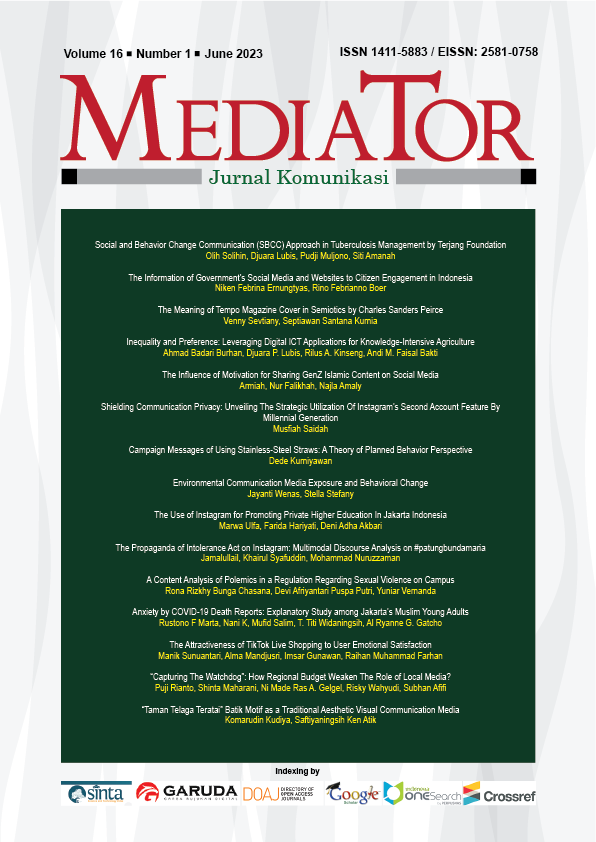The Meaning of Tempo Magazine Cover in Semiotics by Charles Sanders Peirce
DOI:
https://doi.org/10.29313/mediator.v16i1.2311Keywords:
Tempo, Magazine Cover, Pinocchio, AttractivenessAbstract
In the September 16-22, 2019, edition of Tempo, the magazine cover was shown painting a picture of President Joko Widodo’s face with his long nose like a Pinocchio wooden doll. One year later, Tempo republished the magazine cover by displaying a picture of the same figure, namely Pinocchio. But this time in the background of the DPR plenary session on the 11-25 October 2020 edition. This study examines the sign's meaning, the repetition factor in the sign, and the attractiveness of the Tempo magazine cover. The qualitative research method used in this research is the semiotic approach of Charles Sanders Peirce. This research produces a representation of meaning on the two covers, a form of people’s disappointment in public officials for the discrepancy between their words and actions. The factor of repetition of the “Pinocchio” sign that occurs on both covers based on data and facts is found repeatedly. The attractiveness of the Tempo magazine cover includes characteristics, point of view, and target audience, and this attraction results in a business strategy for Tempo magazine.
References
Andersen, E. (2010). Being Strategic: Plan For Success, Out-Think Your Kompetitors, Stay Ahead of Change. ST. Martin’s Griffin.
Anderson, P. T., & Ovaice, G. (2006). Strategic Organization Development: A Seat at The Table. Organization Development Journal, 24(4), 29–37.
Ardianto, & Erdinaya. (2004). Komunikasi Suatu Pengantar. Bandung : simbiosa Rekatama Media.
Baehr, H., & Gray, A. (1996). Turning It On A Reader in Women & Media. St. Martin Press Inc.
Berger, A. A. (2010). Pengantar Semiotika: Tanda-tanda dalam Kebudayaan Kontemporer. Tiara Wacana.
Bungin, B. (2006). Sosiologi Komunikasi Teori, Paradigma, dan Diskursus Teknologi Komunikasi di Masyarakat.
Creswell, J. W. (2014). Penelitian Kualitatif & Desain Riset. Pustaka Pelajar.
Darmawan, F. (2016). Modalitas Visual Kartunis dalam Kartun Politik Online Pascareformasi. Jurnal ILMU KOMUNIKASI, 13(1), 109–122. https://doi.org/10.24002/jik.v13i1.603
Daryono, I. A. (2019). Berbahasa Indonesia dengan Logis dan Gembira.
Horn, R. E. (2001). Visual Language and Converging Technologies in the Next 10- 15 Years (and Beyond). Stanford University.
Ilhami, F., Santosa, H. P., & Setiabudi, D. (2014). Pengaruh Terpaan Pemberitaan Politik Di Media Online Dan Terpaan Pesan Iklan Kampanye Politik Di Media Televisi Terhadap Elektabilitas Partai Hanura. Jurnal Ilmu Komunikasi, 2(2).
Littlejohn, Stephen W, & Foss, K. A. (2009). Teori Komunikasi (9th ed.). Salemba Humanika.
Mackenzie, N., & Knipe, S. (2019). Research dilemmas: Paradigms, Methods and Methodology. Issues In Education Al Research, 16(2), 193–205.
McQuail, D. (2011). Teori Komunikasi Massa. Salemba Humanika.
Moleong, L. J. (2018). Metodologi Penelitian Kualitatif.
Muhammad, B. I., Triyadi, A., & Luhur, U. B. (2019). PINOKIO DAN PERWAKILAN RAKYAT ( ANALISIS SEMIOTIKA COVER MAJALAH TEMPO EDISI 17 OKTOBER 2019 ). 2(1), 26–33.
Mulyana, D. (2010). Pengantar Ilmu Komunikasi. Remaja Rosdakarya.
Noor, J. (2011). Metodologi Penelitian: Skripsi, Tesis, Disertasi, dan Karya Ilmiah. Kencana.
Pramaskara, T. E. (2022). Analisis Semiotika Peirce pada Sampul Majalah Tempo Edisi Jokowi Beserta Bayangan Pinokio. Jurnal Kajian Jurnalisme, 5(2), 209. https://doi.org/10.24198/jkj.v5i2.36251
Santana, S. K., & Othman, S. S. (2019). Investigative Reporting Pattern of Tempo Weekly News Magazine. Humanities & Social Sciences Reviews, 7(1), 19–30. https://doi.org/https://doi.org/hssr.2019.713
Soekarno, & Basuki, L. (2004). Panduan Membuat Desain Ilustrasi Busana Tingkat Dasar. Terampil, Dan Mahir. Kawan Pustaka.
Suprayogo, I., & Tobroni. (2001). Metodologi Penelitian Sosial-Agama. Remaja Rosdakarya.
Widyokusumu, L. (2012). Desain Sampul Majalah Sebagai Ujung Tombak Pemasaran. Humaniora, 3(2).
Downloads
Published
Issue
Section
License
Copyright (c) 2023 Author

This work is licensed under a Creative Commons Attribution-ShareAlike 4.0 International License.























